SRM-AP All News
ALL News
- The pertinence of human activity recognition systems in the present era June 9, 2022
In recent years, human activity recognition has gained significant attention inside the scientific community. The enhanced spotlight is on the ground of its direct application in multiple domains. The latest research at the Department of Computer Science validates this assumption. Assistant Professor Dr V M Manikandan, and the 4th year B Tech Student Chaitanya Krishna Pasula have published a chapter titled An analysis of human activity recognition systems and their importance in the current era in the book Computational Intelligence Based Solutions for Vision Systems. The book is published by IOP Publishing Ltd.
Explanation of the chapter
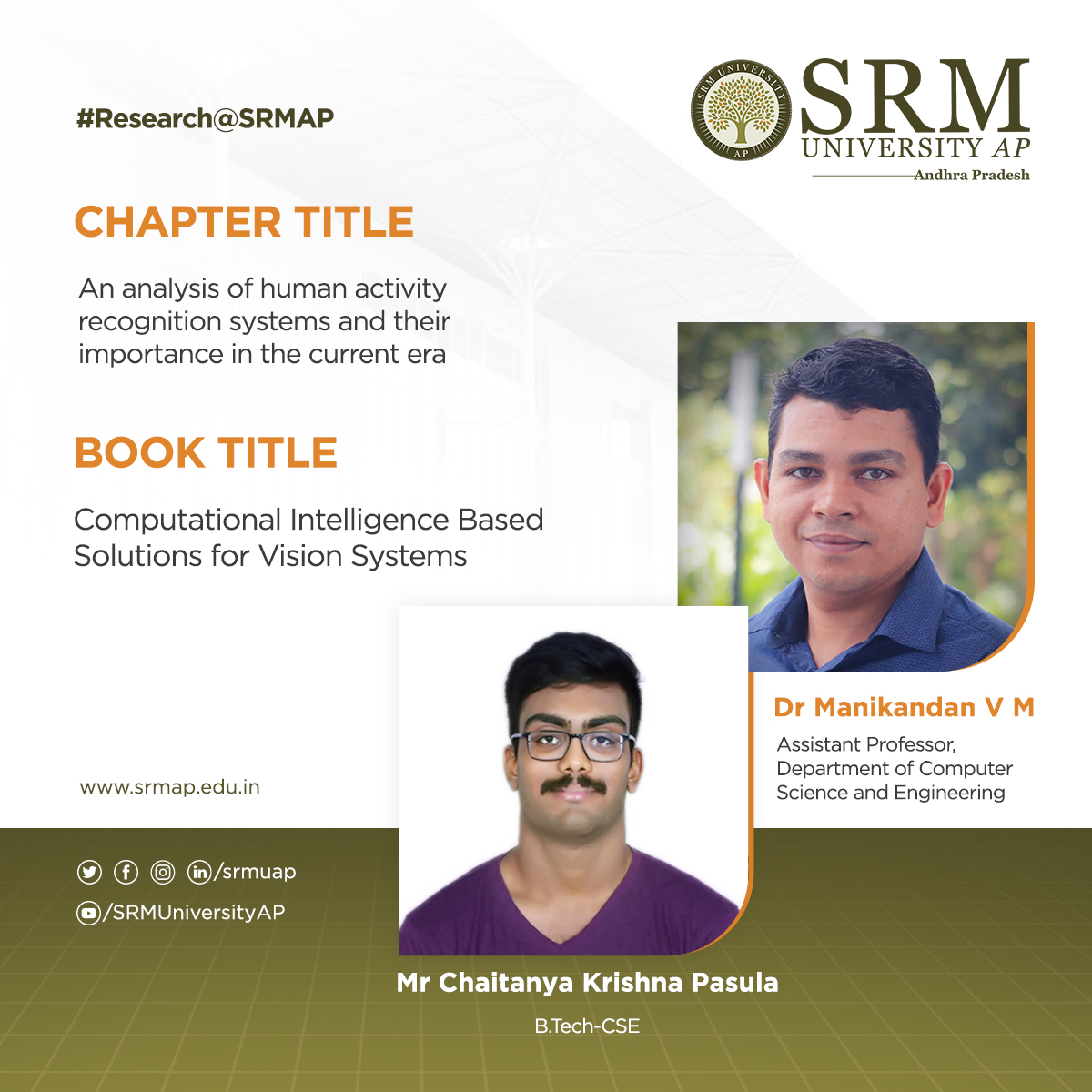 Human activity recognition is one of the most interesting and active research areas in computer vision. More research efforts are being put towards automatically identifying and analysing human activities due to their emerging importance in everyday applications. It serves applications in various areas like security video surveillance, smart homes, healthcare, human-computer interaction, virtual reality, robotics, and digital entertainment. Numerous papers have been published in the domain of human activity recognition. This book chapter discusses the various applications of human activity recognition, different methods available for automatic activity detection from videos, and the advantages of the human activity recognition system. It also describes the challenges in designing and implementing human activity detection schemes. Researchers further explain the publicly available datasets used for training and evaluating the systems for human activity recognition. The efficiency parameters used to evaluate the human activity recognition systems are also briefed in this chapter. The chapter is concluded by comparing the methodologies and speculating the possibilities of future research in this field.
Human activity recognition is one of the most interesting and active research areas in computer vision. More research efforts are being put towards automatically identifying and analysing human activities due to their emerging importance in everyday applications. It serves applications in various areas like security video surveillance, smart homes, healthcare, human-computer interaction, virtual reality, robotics, and digital entertainment. Numerous papers have been published in the domain of human activity recognition. This book chapter discusses the various applications of human activity recognition, different methods available for automatic activity detection from videos, and the advantages of the human activity recognition system. It also describes the challenges in designing and implementing human activity detection schemes. Researchers further explain the publicly available datasets used for training and evaluating the systems for human activity recognition. The efficiency parameters used to evaluate the human activity recognition systems are also briefed in this chapter. The chapter is concluded by comparing the methodologies and speculating the possibilities of future research in this field.In the future, the researchers are planning to design and implement an activity recognition system to identify abnormal activities in public places for safety purposes. This book chapter will be a helpful reference for UG/PG/Ph.D students who aspire to research in the domain of activity detection from video.
Continue reading → - An oil stove burning the waste oil: Innovation of the month June 9, 2022
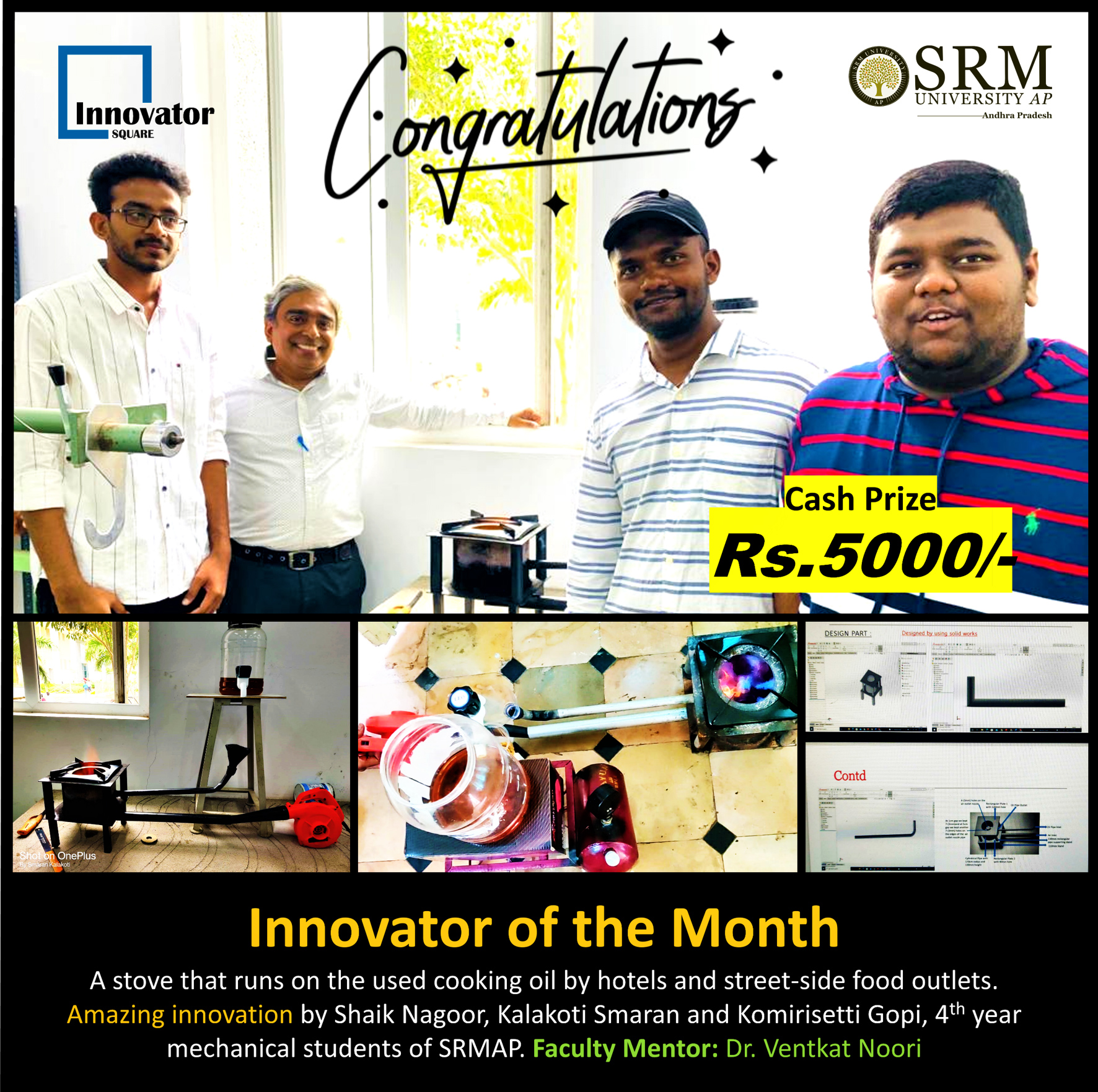
Innovation is seeing what everybody has seen and thinking what nobody has thought.
-Dr Albert Szent-Gyorgyi
The uncompromising vision to mould the students to be the leaders of tomorrow and to gear them up to think beyond the possible has been the propelling factor that drives each student of SRM University-AP to tread the unexplored paths and embrace the unseen challenges. They come out as transformed individuals, outgrown with enriching experiences, capable of introducing new changes into the world. Students are offered ample space and time to ideate, innovate, and build themselves into coming-of-age professionals.
Innovator Square is one such platform set up by the Entrepreneurship-cell to nurture innovative ideas and thoughts having the potential to be converted into a meaningful product or service. Each month, it brings out young talents who have expanded their limits to fashion out an unforeseen solution to the mundane troubles of society. The title winners of the ‘Innovator of the Month’ contest this time, are, Shaik Nagoor, Kalakoti Smaran, and Komirisetti Gopi, from the Department of Mechanical Engineering. They have designed a special stove that runs on used cooking oil.
Introducing innovations out of bits and pieces of the commonest of things adds value to our everyday lives. These budding masterminds deserve acknowledgement for their incredible solution to utilise the leftover oil. Cooking oil is a daily essential abundantly used in food processing industry, such as restaurants and fast food, as well as in households. Reusing the oil is found to have harmful effects as it contains carcinogenic substances, that may lead to cancer or other chronic health disorders. Hence the common practice followed is to dump it in open soil. However, this will affect soil fertility and a myriad of environmental concerns.
Their motive to offer a sustainable solution to this menace is what prompted them to devise a user-friendly stove that will consume the used cooking oil. This will also serve as a better alternative to LPG, saving up to 50% of the expenditure. The students expressed their happiness in having made their tiny share of contribution for the well-being of their society. They also thanked their faculty and the university for extending unswerving support to complete this project. “We can never thank enough Dr Venkata Nori sir for guiding and supporting us from the beginning of our project, he helped us achieve this innovation, we are also thankful to Mr Udayan Bakshi sir for helping us to build a start-up”, they remarked.
Continue reading → - Recasting high-entropy alloys for enhanced performance June 9, 2022
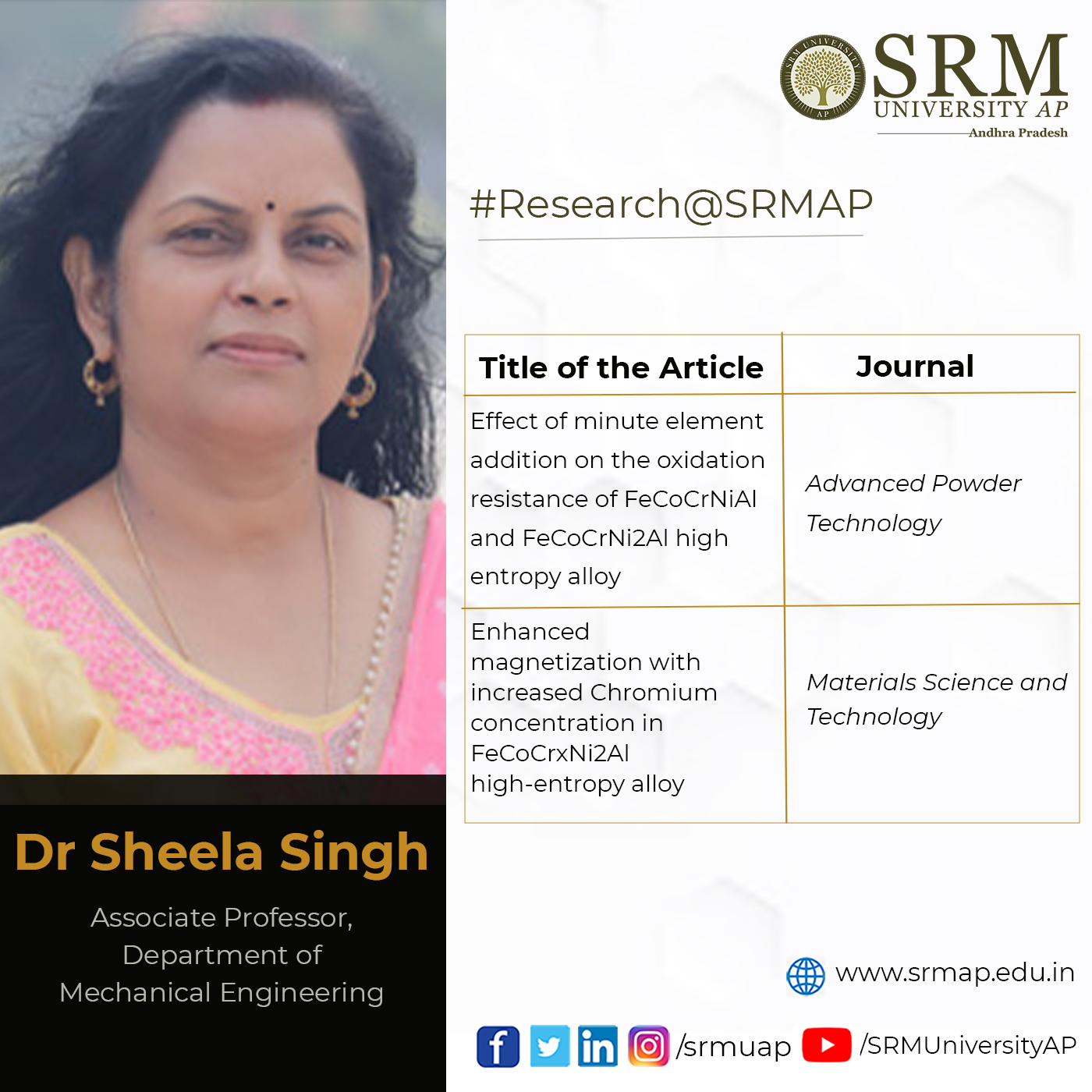
High-entropy alloys (HEAs) are gaining research significance in recent times as they propose novel alloy designs and concepts demonstrating better performance. HEAs constitute multiple principal elements in varying concentrations and combinations to produce new materials with excellent physical properties and superior performance at extreme temperature conditions. Recent studies have brought out a few high-entropy alloys possessing exceptional properties, even capable of challenging the existing theories and models for conventional alloys. However only very little has been explored within this multidimensional space leaving limitless possibilities to be explored and materialized.
Dr Sheela Singh, from the Department of Mechanical Engineering, has been conducting rigorous research in this domain and she has published research articles proposing novel ideas to tweak the properties of HEAs. In one of the articles co-authored by Dr Sheela, “Effect of minute element addition on the oxidation resistance of FeCoCrNiAl and FeCoCrNi2Al high entropy alloy”, published in the journal Advanced Powder Technology, she investigates the effect of Ti0.1 and Ti0.1Si0.1 addition on the high-temperature isothermal oxidation behaviour of dense FeCoCrNiAl and FeCoCrNi2Al high entropy alloys.
Mechanical properties such as hardness & young’s modulus, thermal properties such as melting temperature, specific heat capacity and coefficient of thermal expansion (CTE) were investigated by Nano hardness tester (NHT), differential scanning calorimetry (DSC) and dilatometer, respectively. The phases present in the HEAs produced by hot vacuum pressing and after isothermal oxidation were characterized by X-ray diffraction, Scanning Electron Microscopy and Raman Spectroscopy.
The weight gain recorded after isothermal oxidation for 5,25,50 and 100 hours at 1050°C was found to be parabolic in nature. X-ray diffraction analysis (XRD), as well as Raman spectroscopy analysis of HEA’s oxidized at 1050°C for 100 hours, shows the formation of the Al2O3 phase. A homogeneous thin oxide scale without any discontinuity was observed throughout the cross-section. It has been confirmed that Ti & Si addition in minute amount (0.1 at. % each) improves the mechanical properties and oxidation resistance as well as reduces the waviness of the oxide scale.
Another article co-published by her, “Enhanced Magnetization with Increased Chromium Concentration in FeCoCrxNi2Al High-Entropy Alloy”, in Materials and Science Technology, reports the effect of increasing the concentration of antiferromagnetic element Cr in FeCoCrxNi2Al (x = 0.5, 1.5) High Entropy Alloy (HEA) on their magnetic properties. It was found that the structure and composition of different phases, and the likely degree of spinodal decomposition in the Cr-Fe rich BCC phase significantly affects the magnetic properties.
Interestingly, the sample with Cr concentration x=1.5 showed two times larger saturation magnetization as compared to x=0.5. Furthermore, the magnetization versus temperature response shows a multi-phase character and exhibits distinct behaviour in low temperature and high-temperature regimes in both samples. The obtained soft ferromagnetic behaviour of these HEAs is crucial for the development of a new class of HEA for various applications.
The considerable structural and functional potential, as well as the richness of design, make HEAs promising candidates for new applications prompting further studies in the field. There remains a vast compositional space that is yet to be discovered. New studies have to be initiated finding out effective ways to recognise regions within this space where high-entropy alloys with potentially interesting properties may be lurking. Dr Sheela’s research is a right step in this direction to pave the way for fruitful developments in the future.
Continue reading → - Ameliorated Follow the Leader: Algorithm and Application to Truss Design Problem June 9, 2022
Q1 journal publications of our faculty members always bring honour to SRM University-AP. Dr Priyanka Singh, Assistant Professor from the Department of Computer Science and Engineering has published a paper titled “Ameliorated Follow the Leader: Algorithm and Application to Truss Design Problem” in the journal Structures (Q1 journal) having an impact factor of 2.983.
Abstract
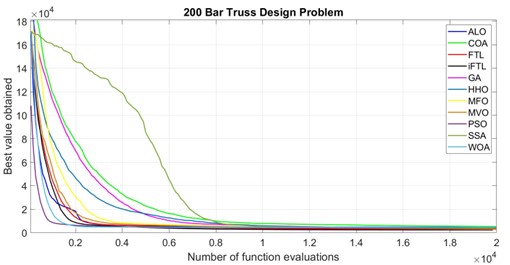 In the real world, resources, time, and money are always limited, necessitating the need for well-balanced algorithms. According to the “No-free-lunch” theorem, no single algorithm exists that works well in all applications. Hence, an optimisation algorithm with improved performance is always needed. The paper presents an improved follow the leader (iFTL) algorithm that imitates the behavioural movement of a sheep within the flock. The algorithm has been utilised to solve eight complex 10, 37, 52, 72, 120, 200, 224, and 942 bar truss design problems.
In the real world, resources, time, and money are always limited, necessitating the need for well-balanced algorithms. According to the “No-free-lunch” theorem, no single algorithm exists that works well in all applications. Hence, an optimisation algorithm with improved performance is always needed. The paper presents an improved follow the leader (iFTL) algorithm that imitates the behavioural movement of a sheep within the flock. The algorithm has been utilised to solve eight complex 10, 37, 52, 72, 120, 200, 224, and 942 bar truss design problems.Practical implications
The algorithm can be utilised to solve several structural and mechanical design problems such as bride design, antenna design, welded beam design, speed reducer, and many more. The algorithm is well suited for all types of real-life engineering problems where optimisation is required, from travel cost optimisation to optimisation of resources in the organisation under the given constraints and objective function.
Collaborators
1. Rahul Kottath (Computer Vision Engineer, Digital Tower, Bentley Systems India Private Limited, Pune, India)
2. Ghanshyam G. Tejani (Assistant Professor, Department of Mechanical Engineering, School of Technology, GSFC University, Vadodara, Gujarat, India)Future Research Plan
Currently, Dr Priyanka is exploring new engineering applications where optimisation techniques can be used. She is working on optimisation methods that can be utilised to classify microarray data, energy optimisation, and mechanical and structural design problems. In future, she plans to propose her work to the industrial level for the greater good and better solutions.
Continue reading → - Computing Influential nodes in complex networks June 7, 2022
With its vast applications in the industry, computing influential nodes is becoming a popular research field in recent days. The Department of Computer Science and Engineering is delighted to inform you that the paper, Computing Influential Nodes Using Nearest Neighborhood Trust Value and Pagerank in Complex Networks have been published by Dr Murali Krishna Enduri, Assistant Professor, Dr Satish Anamalamudi, Associate Professor, and the PhD students; Koduru Hazarathaiah, Ms Srilatha Tokala in the Entropy Journal (Q2 Journal), with an impact factor 2.587.
Abstract
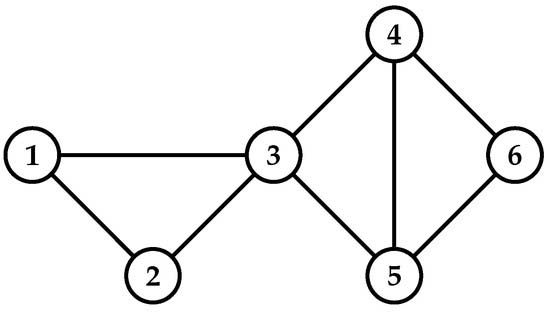 Computing influential nodes attract many researchers’ attention for spreading information in complex networks. It has vast applications such as viral marketing, social leaders, rumour control, and opinion monitoring. The information spreading ability of influential nodes is more compared with other nodes in the network. Several researchers proposed centrality measures to compute the influential nodes in the complex network, such as degree, betweenness, closeness, semi-local centralities, PageRank, etc. These centrality methods are defined based on the local and/or global information of nodes in the network. However, due to the high time complexity, centrality measures based on the global information of nodes have become unsuitable for large-scale networks. Very few centrality measures exist that are based on the attributes between nodes and the structure of the network. We propose the Nearest Neighbourhood Trust PageRank (NTPR) based on the structural attributes of neighbours and nearest neighbours of nodes. We define the measure based on the degree ratio, the similarity between nodes, the trust value of neighbours, and the nearest neighbours.
Computing influential nodes attract many researchers’ attention for spreading information in complex networks. It has vast applications such as viral marketing, social leaders, rumour control, and opinion monitoring. The information spreading ability of influential nodes is more compared with other nodes in the network. Several researchers proposed centrality measures to compute the influential nodes in the complex network, such as degree, betweenness, closeness, semi-local centralities, PageRank, etc. These centrality methods are defined based on the local and/or global information of nodes in the network. However, due to the high time complexity, centrality measures based on the global information of nodes have become unsuitable for large-scale networks. Very few centrality measures exist that are based on the attributes between nodes and the structure of the network. We propose the Nearest Neighbourhood Trust PageRank (NTPR) based on the structural attributes of neighbours and nearest neighbours of nodes. We define the measure based on the degree ratio, the similarity between nodes, the trust value of neighbours, and the nearest neighbours.Explanation of the research
The research computes the influential nodes on the various real-world networks by using the proposed centrality method NTPR. The researchers find the maximum influence by using influential nodes with SIR and independent cascade methods. They also compare the maximum influence of our centrality measure with the existing basic centrality measures.
Social implications
Viral Marketing is a business strategy that uses existing social networks to promote products. The influential nodes in complex networks can be found using the centrality measure and can be used as the seed nodes for promoting products in the social networks. A rumour is a statement being said without knowing if it is true or not. The rumours can be easily controlled by discovering influential nodes. The researchers look forward to finding a centrality measure to detect the influential nodes efficiently.
Continue reading → - The potential applications of NdNiO3 June 7, 2022
Research at the Department of Physics is currently exploring the potential applications of NdNiO3. Recently, Professor Ranjit Thapa, and his Ph D student, Mr Deepak S Gavali published the paper, Low-Temperature Spin-Canted Magnetism and Bipolaron Freezing Electrical Transition in Potential Electron Field Emitter NdNiO3 in the journal ACS Applied Electronic Materials, with an Impact Factor of 3.314. This work is done in collaboration with the Department of Physics and Astronomy, National Institute of Technology Rourkela, Rourkela, Odisha, India.
About the research
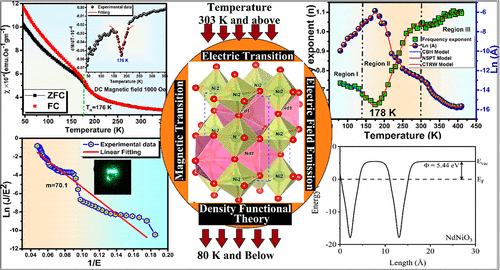 In this work, NdNiO3 nanoparticles are synthesized by sol-gel auto-combustion techniques, and its primary characterization related to structural and surface morphological analysis is carried out by X-Ray Diffraction (XRD), Fourier Transforms Infrared Spectroscopy (FTIR), Field Emission Scanning Electron Microscopy (FESEM), Energy-Dispersive X-ray spectroscopy (EDX), and Transmission Electron Microscopy (TEM) techniques. The research is focused on magnetic phase transition below Curie temperature (TN) ∼176 K, and the magnetic susceptibility indicates a weak antiferromagnetic ordering at low temperature. Different ac conduction mechanisms, that is, Correlated Barrier Hopping (CBH), Continuous-Time Random Walk (CTRW) conduction model, and Non-overlapping Small Polaron Tunneling (NSPT), are introduced to interpret its electrical transport behavior near, above, and below TMI ∼178 K. Using first principles and Density of States (DOS) calculation, the researchers have characterized the electronic and magnetic ground state of NdNiO3 at room temperature. It exposed the overlapping of conduction and valence band at room temperature, and the degree of hybridization between Ni 3d and O 2p is very high compared to Nd 5d states. The work function is also calculated for a few-layer NdNiO3 to estimate the field enhancement factor (β), which plays a crucial role in the practical application of a field emitter.
In this work, NdNiO3 nanoparticles are synthesized by sol-gel auto-combustion techniques, and its primary characterization related to structural and surface morphological analysis is carried out by X-Ray Diffraction (XRD), Fourier Transforms Infrared Spectroscopy (FTIR), Field Emission Scanning Electron Microscopy (FESEM), Energy-Dispersive X-ray spectroscopy (EDX), and Transmission Electron Microscopy (TEM) techniques. The research is focused on magnetic phase transition below Curie temperature (TN) ∼176 K, and the magnetic susceptibility indicates a weak antiferromagnetic ordering at low temperature. Different ac conduction mechanisms, that is, Correlated Barrier Hopping (CBH), Continuous-Time Random Walk (CTRW) conduction model, and Non-overlapping Small Polaron Tunneling (NSPT), are introduced to interpret its electrical transport behavior near, above, and below TMI ∼178 K. Using first principles and Density of States (DOS) calculation, the researchers have characterized the electronic and magnetic ground state of NdNiO3 at room temperature. It exposed the overlapping of conduction and valence band at room temperature, and the degree of hybridization between Ni 3d and O 2p is very high compared to Nd 5d states. The work function is also calculated for a few-layer NdNiO3 to estimate the field enhancement factor (β), which plays a crucial role in the practical application of a field emitter.Practical implications
The additional novelty of the present work is to explore the potential application of NdNiO3 as an efficient field emitter and controlled electron/X-ray sources in a flat panel display, microwave vacuum electronic devices, electron microscopy/ lithography, and so forth. To eject conducting electrons from the metal/semiconducting surface by a quantum mechanical tunneling process, sufficient energy is required in terms of the applied electric field (∼106 to 107 V/cm) to overcome the potential barrier at the vacuum−metal interface. The potential difference between the Fermi level (Ef ) of the metal surface to vacuum is known as the work function (Φ). It depends on material characteristics and plays an essential role in field enhancement capability. The primary requirement for efficient field emitters is high aspect ratios (i.e., field enhancement factor), inferior turn-in field, low work, function, etc. Researchers have examined various classes of materials for efficient field emitter electrodes, such as (i) carbonaceous materials like graphene and carbon nanotube, (ii) various 1D and 2D metal oxide and transition metal dichalcogenides like ZnO, MnO2, In2O3, WS2, WSe2, MoS2, PdSe2, etc., (iii) inorganic semiconductors like SiC and Si, and (iv) wide band gap semiconducting compounds GaN, AIN, and so on. The field emission properties of rare earth nickelates (RNiO3; R = La, Gd, Nd, Sm, etc.) with an exciting room temperature metallic nature have not been examined.
Continue reading → - Applying the Pareto principle in disordered systems June 6, 2022
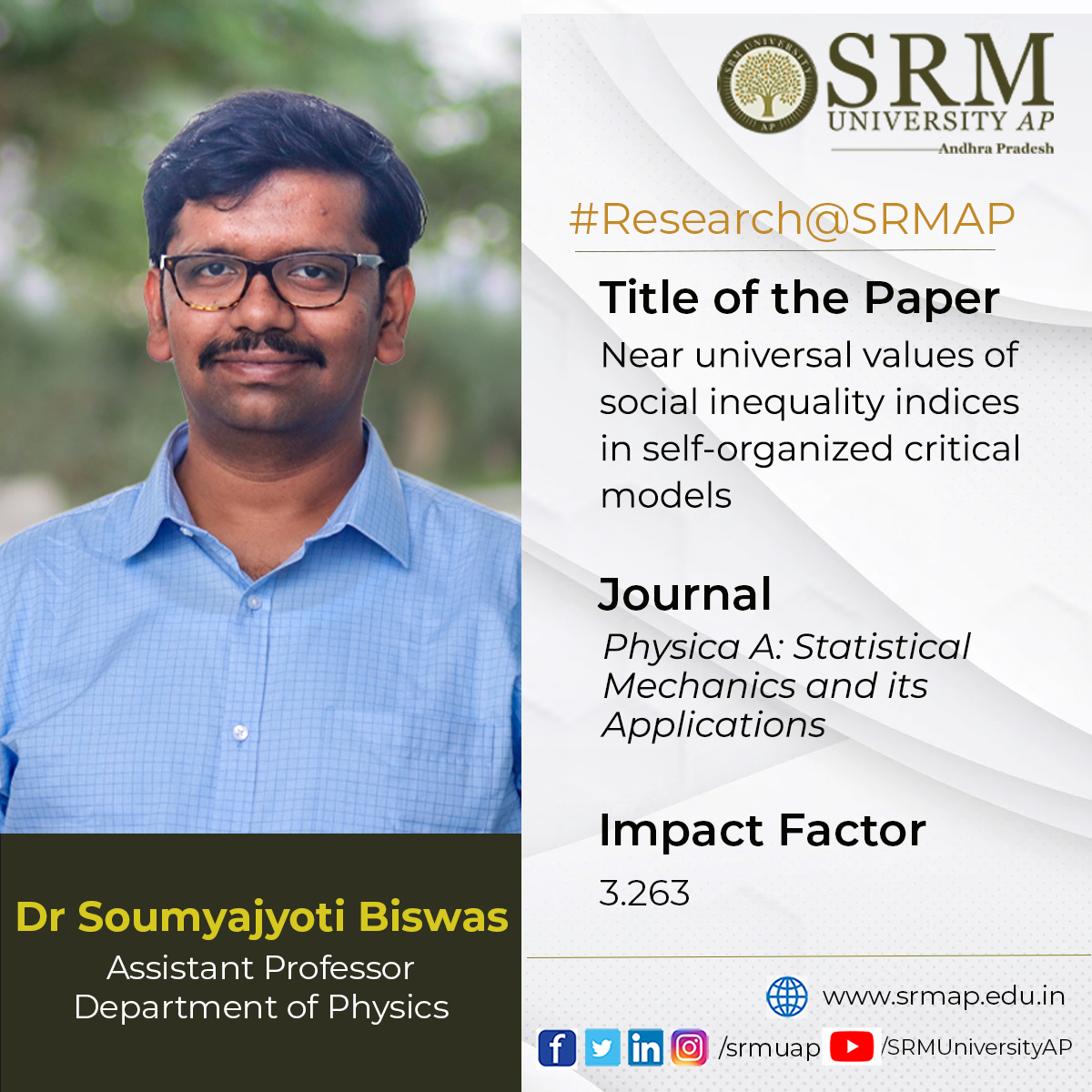
The Department of Physics is glad to announce that Dr Soumyajyoti Biswas, Assistant Professor, has published a paper titled ” Near universal values of social inequality indices in self-organized critical models” in the journal Physica A: Statistical Mechanics and its Applications having an impact factor of 3.263. This research was done in collaboration with Prof S S Manna of S N Bose National Center for Basic Sciences and Prof B K Chakrabarti of Saha Institute of Nuclear Physics.
It is well known that wealth invariably accumulates only in a few hands while a majority of the world continues to remain poor. In economics, it is quantified in Pareto’s 80-20 law (20% of people possess 80% of wealth) or ‘The Law of the Vital Few’. This research reveals that the implication of this law goes far beyond the socio-economic systems. It is also a crucial indicator of the onset of critical phenomena in a wide class of physical systems.
It has been observed that in the dynamics of disordered systems, such as fracture and breakdown of solids, slowly increasing the external force produces acoustic emissions (crackling noise), the sizes of which follow Pareto-like behaviour (most noises are weak, only a few are strong that results in the breakdown). Quantifications of these “inequalities” in these physical systems reveal some universal characteristics in a wide class of models, known as self-organized critical systems.
The main implication of this observation lies in predicting catastrophic breakdown in disordered systems. Applications of these inequality measures, which are traditionally in the domain of social sciences, have proved to be immensely useful in identifying the approaching breakdown points in the models of disordered systems. Given that the methods are applicable to a wide variety of models, the 80-20 law has the potential for a wide range of applications. Dr Biswas and his PhD student Diksha are currently working with a team in Spain on experimental data and studying these inequalities in real systems.
Continue reading → - Research article accepted for IEEE conference IEMTRONICS 2022 June 4, 2022
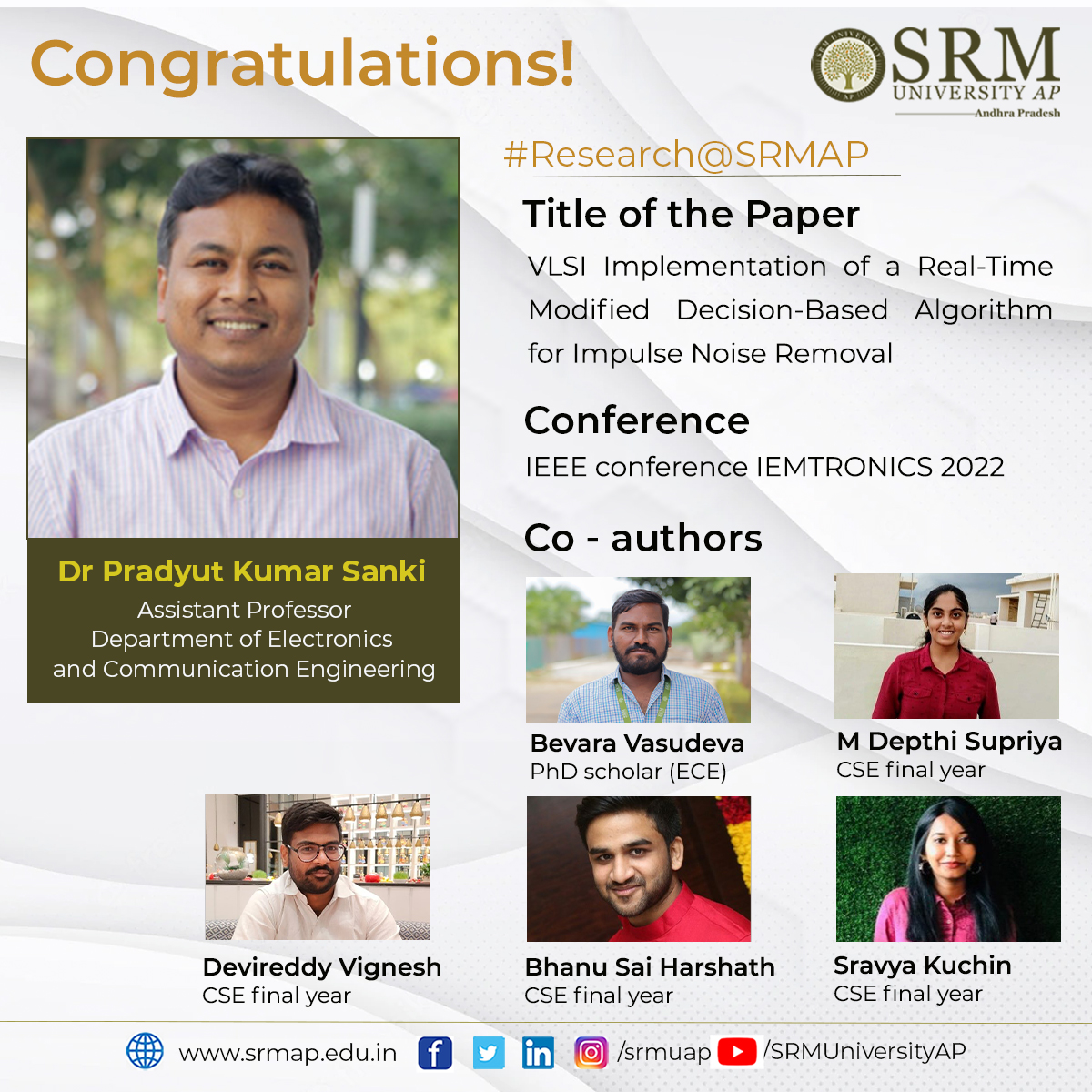
SRM University-AP preserves a research-empowered ecosystem stimulating its faculty and students to roll out original and discerning studies capable of making instrumental contributions aiming the scientific and societal progress. Making strides with impactful research publications and groundbreaking achievements, the institution has carved a niche for itself in the academic milieu. We are glad to present yet another success story of our research community that keeps bringing laurels to the institutions from far and wide.
Dr Pradyut Kumar Sanki and his PhD scholar Bevara Vasudeva, from the Department of Electronics and Communications Engineering, along with a group of Computer Science and Engineering students: Medarametla Depthi Supriya, Devireddy Vignesh, Peram Bhanu Sai Harshath, and Sravya Kuchina have got their paper titled ‘’VLSI Implementation of a Real-Time Modified Decision-Based Algorithm for Impulse Noise Removal’’ accepted in the IEEE conference IEMTRONICS 2022. This publication is a part of the Capstone project contributed by the students.
IEMTRONICS 2022 (International IOT, Electronics and Mechatronics Conference) is an international conclave that aims to bring together scholars from different backgrounds to disseminate inventive ideas in the fields of IOT, Electronics and Mechatronics. The conference will also promote an intense dialogue between academia and industry to bridge the gap between academic research, industry initiatives, and governmental policies. This is fostered by panel discussions, invited talks, and industry exhibits where academia and industry will mutually benefit from each other.
Through the research paper, the team proposes a real-time impulse noise removal (RTINR) algorithm and its hardware architecture for denoising images corrupted with fixed valued impulse noise.
Abstract of the Research
A decision-based algorithm is modified in the proposed RTINR algorithm where the corrupted pixel is first detected and is restored with median or previous pixel value depending on the number of corrupted pixels in the image. The proposed RTINR architecture has been designed to reduce the hardware complexity as it requires 21 comparators, 4 adders, and 2 line buffers which in turn improve the execution time. The proposed architecture results better in qualitative and quantitative performance in comparison to different denoising schemes while evaluated based on the following parameters: PSNR, IEF, MSE, EKI, SSIM, FOM, and visual quality. The proposed architecture has been simulated using the XC7VX330T-FFG1761 VIRTEX7 FPGA device and the reported maximum post place and route frequency is 360.88 MHz. The proposed RTINR architecture is capable of denoising images of size 512 × 512 at 686 frames per second. The architecture has also been synthesized using UMC 90 nm technology where 103 mW power is consumed at a clock frequency of 100 MHz with a gate count of 2.3K (NAND2) including two memory buffers.
Continue reading → - Design methodologies for composite structures in aircraft engines June 3, 2022
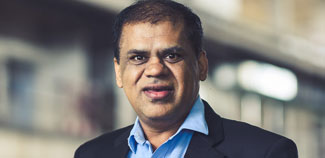 Dr Prakash Jadhav, Professor and Head, Department of Mechanical Engineering at SRM University-AP has published a chapter titled “Design Methodologies for Composite Structures in Aircraft Engines” in the book Advanced composites in aerospace engineering applications, Feb 2022, ISBN 978-3-030-88191-7, Springer.
Dr Prakash Jadhav, Professor and Head, Department of Mechanical Engineering at SRM University-AP has published a chapter titled “Design Methodologies for Composite Structures in Aircraft Engines” in the book Advanced composites in aerospace engineering applications, Feb 2022, ISBN 978-3-030-88191-7, Springer.Abstract of the book chapter
Recently there have been many successful attempts to implement the use of fibre-reinforced composite structures in commercial aircraft engines. The author has been part of these efforts while working in the aviation industry. This article describes these efforts to design, analyze, manufacture, and implement the composite structures inside the low-pressure and low-temperature zones of the engine. Very innovative out-of-the-box design methodologies were used to design these components. These efforts elaborate on the design, optimization, and improvement of the composite fan blade, the composite fan platform, and the composite booster blade inside the engine. It focuses on structural design, aerodynamic efficiency, and specific fuel consumption improvement efforts along with the usual reduction of weight targets. This work successfully demonstrates the systematic steps in the design and implementation like preliminary coupon-level simulations, coupon-level manufacturing, coupon/prototype testing, and final part-level simulations followed by part tests.
The target readers for the book are all engineers, professionals and researchers from the aerospace field. Dr Prakash Jadhav’s future research plan is to continue to develop new methodologies to implement more composites into the aerospace industry. The book chapter will be extremely useful for engineers working on the design of composite structures for aerospace applications.
Continue reading → - An IoT- based smart wallet prototype June 2, 2022
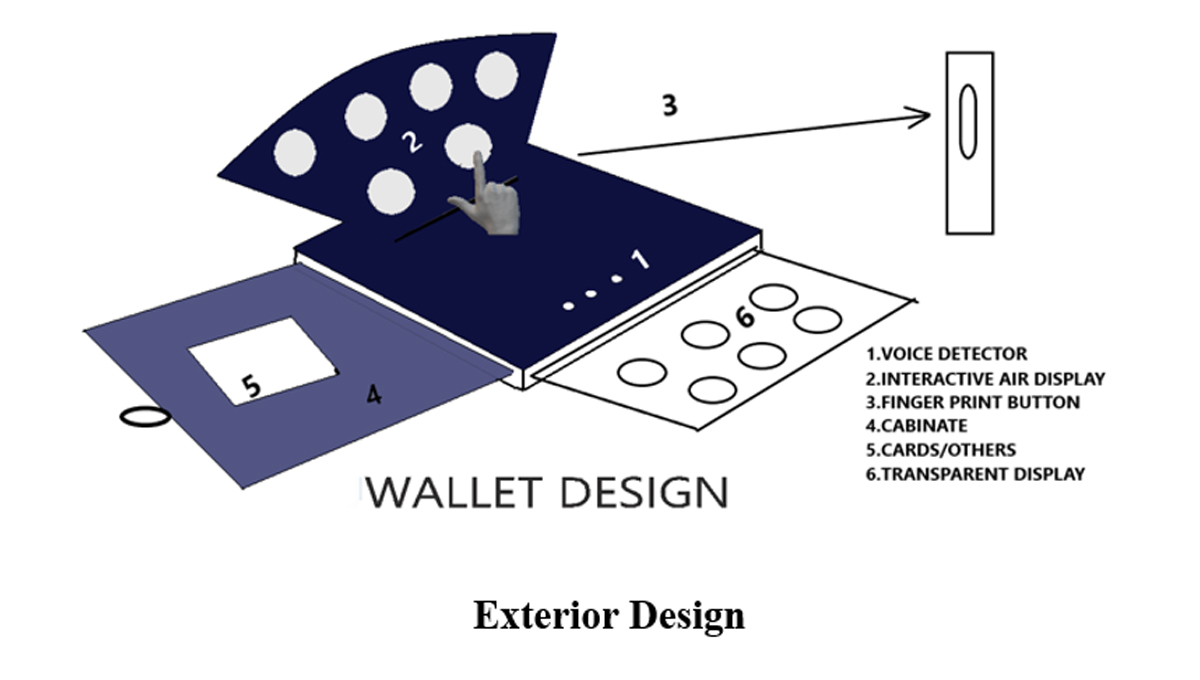 Dr Sonam Maurya, and her research team; Soha Muskaan Sayyad, Trisha Chilukuri, Samah Maaheen Sayyad, and Juhita Naga Priya Velagapudi from the Department of Computer Science and Engineering have innovated a smart wallet model based on IoT and got their patent “Smart Wallet with Enhanced Features for Preventing Misuse and Alarm System for the Same” published. This is a fitting solution to protect against the loss and theft of the wallet.
Dr Sonam Maurya, and her research team; Soha Muskaan Sayyad, Trisha Chilukuri, Samah Maaheen Sayyad, and Juhita Naga Priya Velagapudi from the Department of Computer Science and Engineering have innovated a smart wallet model based on IoT and got their patent “Smart Wallet with Enhanced Features for Preventing Misuse and Alarm System for the Same” published. This is a fitting solution to protect against the loss and theft of the wallet.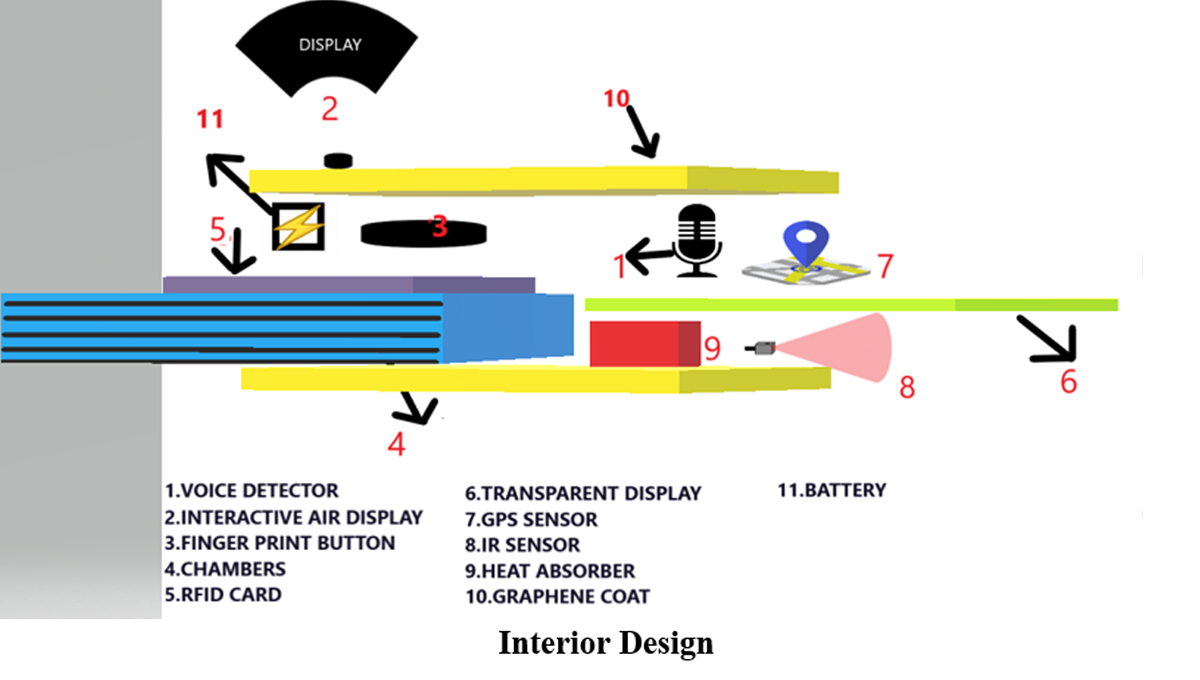 A smart wallet is an excellent technology to safeguard your credit and debit cards. Wallets these days are getting smarter with the latest technologies induced to monitor its presence. The proposed IoT- based wallet model is more smart, intelligent, secure, and safe which encompasses the best use of the latest IoT technologies in our pocket. The prototype consists of fingerprinting access technology, Augmented Reality (AR) navigation, Interactive Air Display (IAD)/ Transparent Display (TD), Voice control mechanism, Emergency alerts, RFID features, and many more. The smart wallet is designed to overcome the shortcomings of the regular wallet types.
A smart wallet is an excellent technology to safeguard your credit and debit cards. Wallets these days are getting smarter with the latest technologies induced to monitor its presence. The proposed IoT- based wallet model is more smart, intelligent, secure, and safe which encompasses the best use of the latest IoT technologies in our pocket. The prototype consists of fingerprinting access technology, Augmented Reality (AR) navigation, Interactive Air Display (IAD)/ Transparent Display (TD), Voice control mechanism, Emergency alerts, RFID features, and many more. The smart wallet is designed to overcome the shortcomings of the regular wallet types.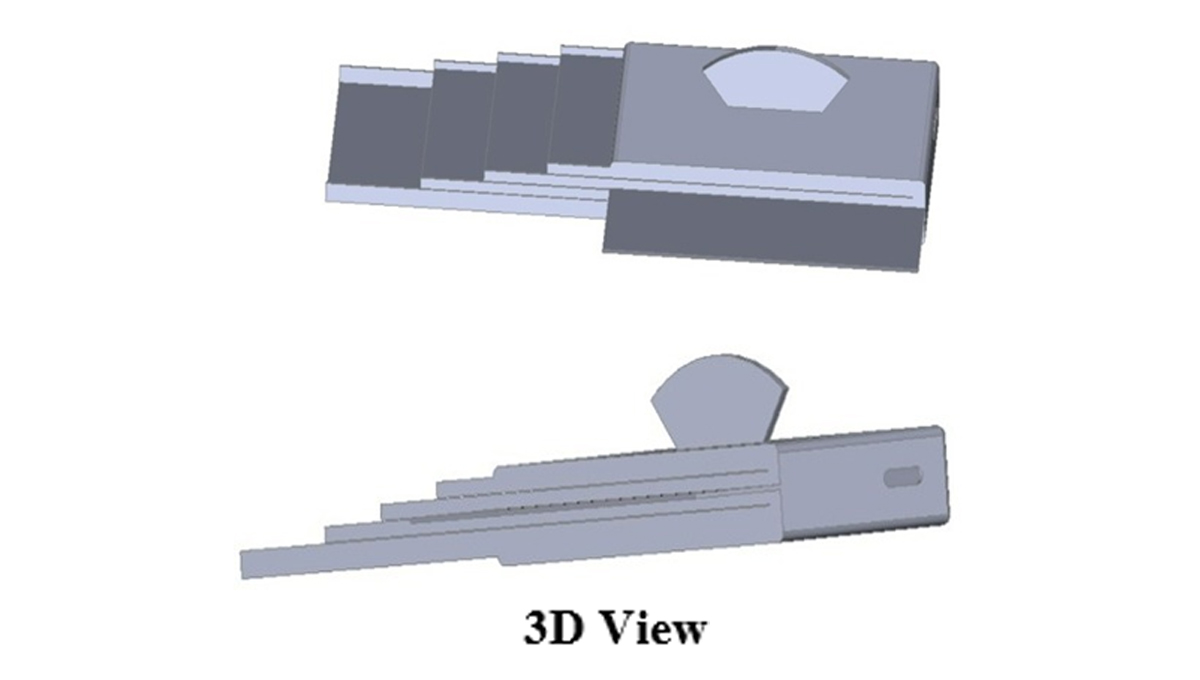 The new technology of AR makes the tracking of the wallet easier with a graphical pathway. And the voice control functionalities help the user to make the process easier in comparison to manual opening. IAD/ TD is used to control the mechanisms like opening the card or money case. To keep the data more secure from hackers, an RFID technology-enabled card is also embedded in the wallet. The strong Graphene outer covering is used to make the materials inside more flexible and safer. Besides, there is an emergency voice control mechanism that takes the instruction from the user and makes the surroundings alert by sending an alert message to the emergency contacts. And the cash counting facility in the wallet to keep track of the cash makes it a wholesome package of digital innovation.
The new technology of AR makes the tracking of the wallet easier with a graphical pathway. And the voice control functionalities help the user to make the process easier in comparison to manual opening. IAD/ TD is used to control the mechanisms like opening the card or money case. To keep the data more secure from hackers, an RFID technology-enabled card is also embedded in the wallet. The strong Graphene outer covering is used to make the materials inside more flexible and safer. Besides, there is an emergency voice control mechanism that takes the instruction from the user and makes the surroundings alert by sending an alert message to the emergency contacts. And the cash counting facility in the wallet to keep track of the cash makes it a wholesome package of digital innovation.The social implications of this smart wallet are:
• Enhanced features for preventing wallet misuse
• Alarm system to help in emergencies and threatening situations
• Best use of IoT technology in a user-friendly way
• Enabled with Wallet/ Card missing notifications
• Eco-friendly charging mechanism
With this innovation, the research team aims to bring technology to its fullest use to make significant transformations in the everyday life of society.
Continue reading →

